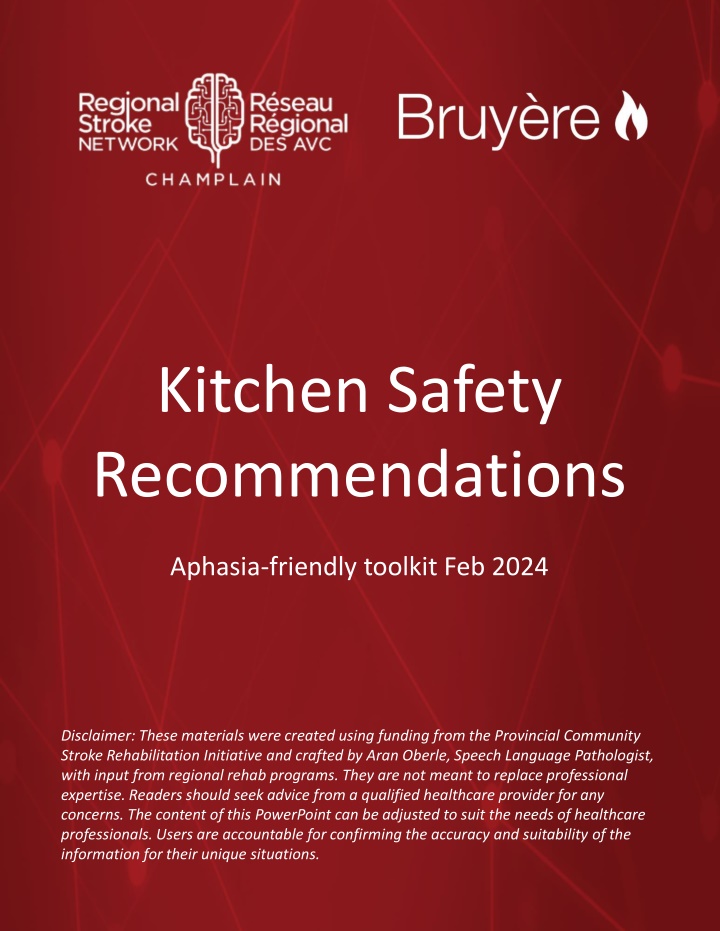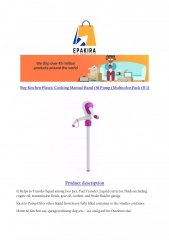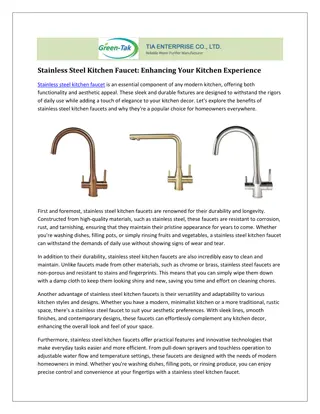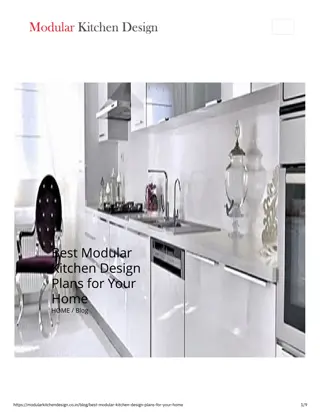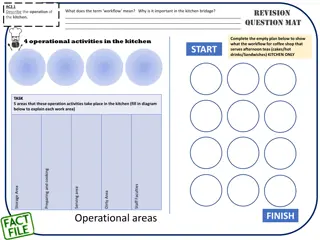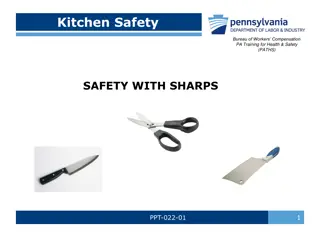Kitchen Safety Recommendations
Safety tips for kitchen environment, stove usage, food preparation, eating, and cleaning up to prevent accidents. Includes practical advice and adaptations for individuals with aphasia. Funding from Provincial Community Stroke Rehabilitation Initiative. Not to replace professional expertise.
Download Presentation

Please find below an Image/Link to download the presentation.
The content on the website is provided AS IS for your information and personal use only. It may not be sold, licensed, or shared on other websites without obtaining consent from the author.If you encounter any issues during the download, it is possible that the publisher has removed the file from their server.
You are allowed to download the files provided on this website for personal or commercial use, subject to the condition that they are used lawfully. All files are the property of their respective owners.
The content on the website is provided AS IS for your information and personal use only. It may not be sold, licensed, or shared on other websites without obtaining consent from the author.
E N D
Presentation Transcript
Kitchen Safety Recommendations Aphasia-friendly toolkit Feb 2024 Disclaimer: These materials were created using funding from the Provincial Community Stroke Rehabilitation Initiative and crafted by Aran Oberle, Speech Language Pathologist, with input from regional rehab programs. They are not meant to replace professional expertise. Readers should seek advice from a qualified healthcare provider for any concerns. The content of this PowerPoint can be adjusted to suit the needs of healthcare professionals. Users are accountable for confirming the accuracy and suitability of the information for their unique situations.
Kitchen Safety Recommendations Here are some safety tips for in the kitchen. To prevent accidents, it is important to consider the following: 1. Kitchen Environment 2. Using the Stove 3. Preparing Food 4. Eating 5. Cleaning Up Questions? Occupational Therapist (OT): ___________________________ 6. General Safety * This list is not complete. There may be other things to consider for safety in your home. Adapted from: Bruyere Continuing Care. (2020). Occupational Therapy Kitchen Safety Information.
1. Kitchen Environment Lower countertop height for wheelchair use OR complete prep at a table A side-by-side fridge makes using freezer easy with no bending Keep common foods and spices in an easy-to-reach area. De-clutter shelves. Adapted from: Bruyere Continuing Care. (2020). Occupational Therapy Kitchen Safety Information.
1. Kitchen Environment Labels in large print help find things fast Nonskid Dycem mats stop bowls slipping when mixing A mirror above the stove helps see inside pots and pans Adapted from: Bruyere Continuing Care. (2020). Occupational Therapy Kitchen Safety Information.
2. Using the Stove Never leave the kitchen when cooking Use the stove's back burners, not the front burners Try to cook only one thing on the stove at a time Buy a stove with front controls to stop reaching over burners Adapted from: Bruyere Continuing Care. (2020). Occupational Therapy Kitchen Safety Information.
2. Using the Stove Purchase a stove with an automatic shut off function Cook at lower temperatures to prevent burns Clear space near the stove/oven for hot dishes taken from oven Use a pot handle stabilizer to stop tipping pots Adapted from: Bruyere Continuing Care. (2020). Occupational Therapy Kitchen Safety Information.
3. Preparing Food Ask for help cutting fruits/vegetables or buy pre-cut foods Non-slipcutting boards with rubber/suction cups to stabilize To open containers, use an electric can opener or a one-handed jar opener Adapted from: Bruyere Continuing Care. (2020). Occupational Therapy Kitchen Safety Information.
3. Preparing Food Use microwave, toaster oven, or crock pot to make meals. Freeze extra for quick reheating later Sit while preparing food to conserve your energy Adapted from: Bruyere Continuing Care. (2020). Occupational Therapy Kitchen Safety Information.
4. Eating Use a rocker knife to cut food Use built-up utensils if you have difficulty grasping small items Use your walker to transport food from the kitchen to the table Put a saucer under cups/bowls when transporting to the table Adapted from: Bruyere Continuing Care. (2020). Occupational Therapy Kitchen Safety Information.
4. Eating Consider using a cup with lid on it to prevent spills Rimmed plates make scooping your food easier Put nonskid placemats under dishes to stop slips when eating Use non-breakable dishesin plastic or Corelle Adapted from: Bruyere Continuing Care. (2020). Occupational Therapy Kitchen Saftey Information.
5. Cleaning Up Install lever-handled faucets that you can turn on and off with your wrists or arm Use a dish drainer in the sink to hold dishes steady while washing and rinsing. Clean dishes can then be put in a separate dish rack to dry - Adapted from: Bruyere Continuing Care. (2020). Occupational Therapy Kitchen Safety Information.
5. Cleaning Up Use pump-top dish soap instead of a squeeze bottles. You can also buy a sponge with a handle that can be filled - with soap Avoid reaching + bending by leaving a clean potout instead of putting it away each time Do NOT put sharp utensils in sink to soak. Wash sharp tools in your hand. Adapted from: Bruyere Continuing Care. (2020). Occupational Therapy Kitchen Safety Information.
6. General Safety Keep baking soda beside stove for grease fires Keep a fire extinguisher near stove Keep oven mitts and potholders near stove to avoid accidentally grabbing a hot dish. Some oven mitts have magnets to stick on the oven - Adapted from: Bruyere Continuing Care. (2020). Occupational Therapy Kitchen Safety Information.
Stratgies pour augmenter la s curit dans la cuisine Voici des recommendations pour augmenter la s curit et l'ind pendance dans la cuisine. Pour viter des accidents, consid rez: 1. L'environnement physique 2. L'utilisation du four et /ou de la cuisini re 3. La pr paration 4. Manger 5. Le nettoyage 6. Consid rations g n rales *Cette listen estpas compl te. Il peut y avoir d autres l ments prendre en consid ration pour la s curit chez vous. Questions? Ergoth rapeute (OT): ___________________________ Adapt de: Bruyere Continuing Care. (2020). Occupational Therapy Kitchen Safety Information.
1. Environment Physique Abaisser la hauteur du comptoir pour l utilisation en fauteuil roulant OU pr parer les ingr dients table Un r frig rateur c te c te facilite l utilisation du cong lateur Garder les aliments et les pices souvent utilis s dans une zone facile atteindre. D sencombrer les tag res. Adapt de: Bruyere Continuing Care. (2020). Occupational Therapy Kitchen Safety Information.
1. Environment Physique Les tiquettes en groscaract res aident trouver rapidement ce que l'on cherche Tapis Dycem anti-d rapant emp chent les bols de glisser lors du m lange Un miroir au-dessus de la cuisini re montre l int rieur des casseroles Adapt de: Bruyere Continuing Care. (2020). Occupational Therapy Kitchen Safety Information.
2. L'utilisation du four et /ou de la cuisinire Ne jamais quitter la cuisine lorsque l on cuisine Utiliser les feux arri res de la cuisini re, pas les feux devant Ne faire cuire qu un seul item la fois Acheter une cuisini re avec commandes frontales pour ne plus avoir vous pencher sur les br leurs. Adapt de: Bruyere Continuing Care. (2020). Occupational Therapy Kitchen Safety Information.
2. L'utilisation du four et /ou de la cuisinire Acheter une cuisini re avec fonction d arr t automatique Cuisiner basse temp rature pour viter les br lures Cr er de l'espace libre pr s de la cuisini re/du four pour d poser des plats chauds pris du four Utiliser un stabilisateur de poign e pour emp cher les pots de basculer Adapt de: Bruyere Continuing Care. (2020). Occupational Therapy Kitchen Safety Information.
3. La prparation Demander de l aide pour couper les fruits ou les l gumes ou acheter des aliments coup s Utiliser des planches d couper anti-d rapantes avec du caoutchouc/des ventouses pour stabiliser Pour ouvrir les contenants, utiliser un ouvre-bo te lectrique ou un ouvre-pot une main. Adapt de: Bruyere Continuing Care. (2020). Occupational Therapy Kitchen Safety Information.
3. La prparation Utiliser un four micro-ondes, un grille-pain ou une mijoteuse pour pr parer vos repas. Congeler les restes pour les r chauffer plus tard. S asseoir pour pr parer la nourriture, pour faire la cuisson ou pour faire la vaisselle afin de conserver de l nergie. Adapt de: Bruyere Continuing Care. (2020). Occupational Therapy Kitchen Safety Information.
4. Manger Utiliser un couteau fil convexe pour couper Utiliser des ustensiles modifi s si vous avez des difficult s manipuler des petits objets Utiliser votre marchette pour amener les aliments de la cuisine la table Mettre une soucoupe sous les tasses / bols lors du transport la table Adapt de: Bruyere Continuing Care. (2020). Occupational Therapy Kitchen Safety Information.
4. Manger Utiliser une tasse avec couvercle pour viter les d versements Les assiettes rebord peuvent faciliter l'utilisation des ustensiles Placer des napperons antid rapants sous la vaisselle Utiliser des plats incassables en plastique ou en Corelle Adapt de: Bruyere Continuing Care. (2020). Occupational Therapy Kitchen Safety Information.
5. Nettoyage Installer des robinets levier que vous pouvez ouvrir et fermer avec votre poignet ou votre bras Utiliser un gouttoir vaisselle dans l vier pour garder la vaisselle stable pendant le lavage et le rin age. Les plats propres peuvent ensuite tre mis dans un porte- vaisselle s par pour s cher - Adapt de: Bruyere Continuing Care. (2020). Occupational Therapy Kitchen Safety Information.
5. Nettoyage Utiliser du savon vaisselle pompe la place des bouteilles compressibles. Utiliser une ponge avec une poign e qui peut tre remplie de savon - viter de vous pencher lors du rangement. Laisser un pot propre port e de main au lieu de le ranger chaque fois. Ne PAS mettre d ustensiles tranchants tremper dans l vier. Laver les outils tranchants en main. Adapt de: Bruyere Continuing Care. (2020). Occupational Therapy Kitchen Safety Information.
6. Considrations gnrales Garder le bicarbonate de soude c t de la cuisini re pour les feux de graisse Garder un extincteur pr s de la cuisini re Garder les mitaines four pr s de la cuisini re pour viter de prendre un plat chaud accidentellement. Certains mitaines four ont des aimants pour les coller au four - Adapt de: Bruyere Continuing Care. (2020). Occupational Therapy Kitchen Safety Information.
